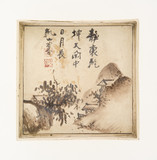Born as the third son of the proprietor of Kariganeya, a kimono merchant in Kyoto, Kenzan was the younger brother, of master painter, Ogata Kōrin. In 1687, in accordance with his father's will, Kenzan inherited three mansions, books, and gold and silver, on a fifty-fifty basis with Kōrin. In contrast to his older brother Kōrin, who was a flamboyant playboy who burned through his inheritance, Kenzan was introverted, loved books, and preferred to live a modest life. In 1689, he set up Shuseidō hall to the south of Ninnaji Temple and devoted himself to meditation and learning. The great potter Ninsei Nonomura (active 1640s-1690s) lived in front of the gate of Ninnaji Temple, and Kenzan seems to have learned pottery from Ninsei in earnest. He had also received lessons from Kōetsu's grandchildren Koho and Rakuichi from an early age. At the age of 37, Tsunahira Nijo , who had been eyeing the Ogata brothers for some time, gave him a mountain villa in Narutaki, Izumiya. Since the place was located in the northwest direction of the capital, he called it 'Kenzan' (dry mountain) and signed his work with that name. In 1712, at the age of 50, he moved to Nijo street in Kyoto City and produced a great deal of work. His style is characterized by a free-spirited painting and a rustic taste blended with sophistication, and there are many collaborative pieces in which Kenzan made the vessel and Kōrin painted the design. In 1731, at the age of 69, Kenzan was invited by Cloistered Imperial Prince Rinnojinomiya Kinkan to move to Iriya, Edo (now Tokyo). From September to early winter in 1737, he taught pottery in Sano, Shimotsuke Province. He later returned to Edo and died at the age of 81.
Kenzan Ogata
2 records
Include records without images
About this artist

